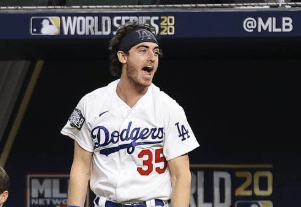With a contract of $27.5 million for the 2025 season, Cody Bellinger’s persistent talent and his incredibly successful comeback story are both amply demonstrated. Only two years ago, his market worth had dropped dramatically due to injuries and slumps, raising doubts about his ability to regain his position as an elite player. His salary now places him squarely in the top tier of MLB salaries, eerily comparable to that of other MVP-caliber players who control the league’s financial discourse.

His three-year, $80 million contract with the Chicago Cubs was crafted with adaptability and durability in mind. Op-out clauses worth $2.5 million in 2025 and $5 million in 2026 are included in the arrangement, which has an average annual cost of $26.6 million. These clauses, which are especially helpful for athletes facing uncertain futures, provide salary guarantees together with the option to reenter free agency in the event that market conditions improve. Bellinger’s career story has been effectively reshaped by the system, which is immensely adaptable and strikes a balance between player security and team risk.
Cody Bellinger – Bio Data and Professional Information
| Detail | Information |
|---|---|
| Full Name | Cody James Bellinger |
| Date of Birth | July 13, 1995 (Age 29 in 2025) |
| Birthplace | Scottsdale, Arizona, USA |
| Profession | Professional Baseball Player |
| Current Team | New York Yankees |
| Position | Outfielder / First Baseman |
| MLB Debut | April 25, 2017 (Los Angeles Dodgers) |
| Career Highlights | Rookie of the Year (2017), NL MVP (2019), World Series Champion (2020) |
| Current Contract | 3 years / $80 million with Chicago Cubs (through 2026) |
| Average Annual Salary | $26,666,667 |
| 2025 Base Salary | $27,500,000 |
| Estimated Net Worth | $57 million |
| Authentic Resource |
His pay provides a strong argument for his worth when compared to other celebrities. Bryce Harper makes roughly $27 million a season, while Aaron Judge’s lucrative contract with the Yankees averages $40 million yearly. Even though Bellinger’s overall deal is shorter, his physique is extremely effective in placing him near the sport’s idols. This is in line with a trend where clubs are choosing high-value, shorter contracts over megadeals that last ten years. This arrangement proved to be incredibly resilient for Bellinger, enabling him to reestablish his reputation and financial position without being constrained by a strict framework.
The diamond is only one aspect of his financial situation. With Nike, Rawlings, Old Spice, and Dairy Queen among his most well-known partners, endorsements have grown to be a consistent source of income for him. Even though his estimated yearly endorsement income of $2.5 million is small in comparison to his playing wage, his transfer to New York has significantly increased it. His brand awareness in the Yankees’ public eye has greatly allayed any remaining concerns regarding his marketability and enhanced his off-field presence.
Resilience is woven throughout the tale of how he attained this pay level. With his tremendous power at the plate, Bellinger made his debut with the Dodgers in 2017 and was named Rookie of the Year. He was able to establish himself as one of the sport’s most promising young players with remarkable success during his 2019 campaign, in which he won MVP. He helped Los Angeles win its first World Series in more than thirty years a year later by making key postseason contributions. But in 2021 and 2022, injuries and protracted difficulties raised doubts about his long-term worth.
His Cubs season of 2023 changed his life. Critics were hushed by his remarkably evident comeback, which included better batting averages and a return to Gold Glove form. He demonstrated the expanding convergence of performance, timing, and financial opportunity by turning this comeback into a profitable deal. His journey is eerily similar to those of athletes like Josh Donaldson, who used short-term contracts to rebuild their careers, demonstrating that perseverance and flexibility can be incredibly successful tactics in contemporary sports.
Bellinger’s $27.5 million salary is more than just a figure to Yankees supporters. The team has made a commitment to invest in players with demonstrated skill and leadership in order to pursue titles. His arrival in New York has an impact that extends well beyond the field; it increases ticket sales, stimulates sponsorships, and strengthens the Yankees’ reputation as a team that doesn’t compromise on ambition. In baseball economics, his salary serves as a metaphor for how elite sportsmen propel financial ecosystems, which are remarkably cheap in relation to the billions they contribute to.
His projected net worth of $57 million is a result of early-career bonuses, endorsement deals, and MLB contracts. Even while Bellinger isn’t yet as wealthy as Mike Trout or Mookie Betts, his career path is remarkably resilient for a player under thirty. As endorsements in the New York market increase—especially if playoff success ensues—his financial legacy is probably going to grow considerably more quickly. His ascent serves as an example of how strategic alliances with high-profile celebrities may be especially advantageous for medium-sized companies researching athlete sponsorships.
Many questioned if the enormous athlete pay could continue during the pandemic, when stadiums were deserted and income fell. However, the years of recovery demonstrated the business rationale: celebrities like Bellinger turn franchises into major entertainment properties. His situation serves as a reminder that pay scales need to be weighed against bigger returns, such as item sales, broadcast ratings, and the sentimental commitment of millions of followers. His deal is a striking example of how contemporary baseball survives by fusing financial strategy with cultural resonance.
